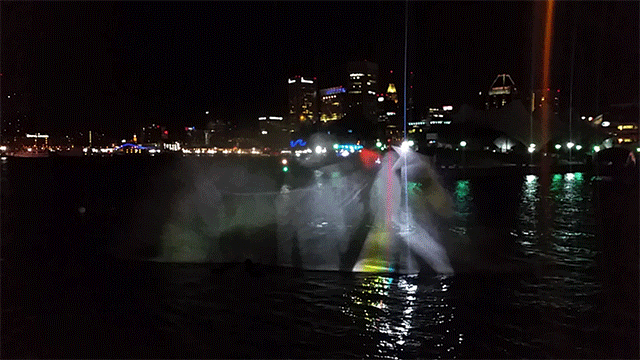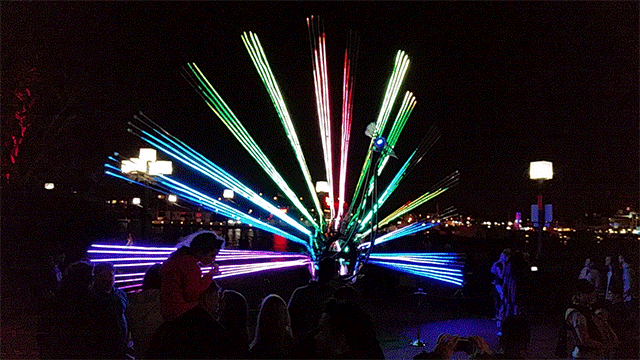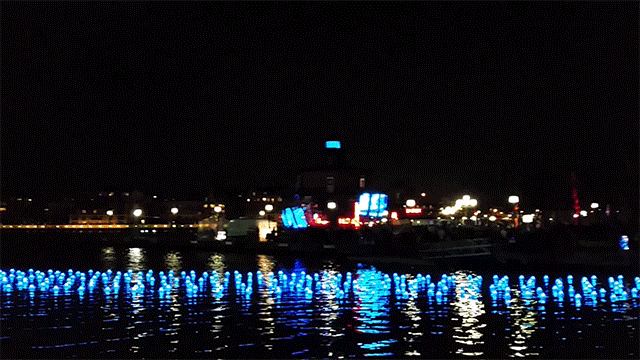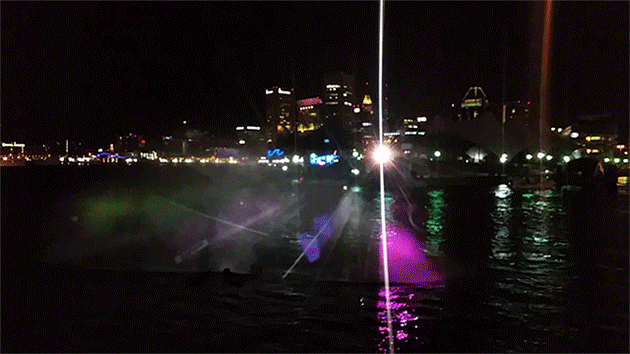
“Water Wall” by Greg St. Pierre and Andrew Bernstein, (L) with “Diamonds Light Baltimore” (R) by Mina Cheon and Gabriel Kroiz.
For the past year, residents of Baltimore have been bombarded with hype about Light City, a free festival of music and “light art” in the tourist-trap Inner Harbor. The organizers have repeatedly compared it to South by Southwest and Art Basel (two extremely dissimilar events) and secured roughly $4 million in funding from a mix of public and private sponsors. But it seems like the only people excited about Light City are the people who paid for this thing. For the most part, I’ve been pretty ambivalent.
Excluding the handful of local artists who received commissions, almost everyone in the art scene here expressed indifference or irritation with Light City. The event was a week-long carnival-esque light show and concert series designed to convince tourists that Baltimore is “innovative” by appealing to the logic that people like shiny things. It’s the latest pet project of the Baltimore Office of Promotion and the Arts (BOPA) perceived as wildly missing the mark in regards to serving the city’s artists. BOPA also organizes Artscape, which we’ve been critical of in the past. That isn’t to say Light City is a terrible thing, it’s just terribly ill-conceived.
Describing Light City as “The Art Basel of Baltimore” is arguably one of the most specious analogies I’ve encountered in my career of reading and writing about art. Art Basel is an international commercial art fair that attracts collectors, critics, and curators from around the world and exists for the purpose of/is funded mostly by many different galleries renting booths. Light City is a spectacle of lights in public spaces funded largely by an energy company, real estate interests, and quasi-public institutions with the goal of attracting families from the suburbs to downtown Baltimore. Whereas Art Basel exists to sell art, Light City exists in the hopes that visitors spend money on parking, overpriced bracelets that allow one to drink in designated outdoor areas, and maybe dinner at the Cheesecake Factory. That’s a pretty big difference. I wasn’t even planning on attending.
To put that in perspective, I live exactly 1.7 miles from the Inner Harbor and there is a free bus line that connects my neighborhood to the heart of the festival. I’ve done sleepless roadtrips in the backseat of packed cars to attend Art Basel Miami Beach. I’ve spent 30 hours on a train to visit the Prospect Biennial in New Orleans. Earlier this year, I spent entirely too much time and money procuring a replacement passport to fly to Mexico City for Zona MACO and Material Art Fair. I’m willing to jump through those hoops because the art world, for all it’s problems, offers intellectual rewards beyond spectacle. Light City just wasn’t on the radar of most people who care about art because its promotion was so schlocky and concept so vapid. Paddy described one press release as looking “like the kind of event that a tech corporation might launch once a year to say thank you to their employees… far off from the kind of thing an art person would care about.” I only even realized it was happening last week when I was looking at the skyline from my bedroom window and noticed that many buildings had switched their architectural lighting to color-changing LEDs.

“Peacock” by Tim Scofield & Kyle Miller. I am a little embarrassed by how mesmerizing I found this.
I did find myself in the Inner Harbor (for another event) during the festival, though. Not checking out Light City would’ve been akin to deliberate avoidance. It wasn’t what I expected. The promotional materials seemed to suggest Baltimore’s waterfront would temporarily look like the every-night light show that is Shanghai’s skyline crossed with Las Vegas’s Bellagio Fountains. In reality, the event wasn’t nearly as grand in scale. I was underwhelmed, as was nearly everyone I spoke to. (Brett McCabe of Bmore Art explains this hilariously in his review of the affair.)
Scattered around 1.5 miles of waterfront promenade in a “C” shape, even viewing the installations required a commitment. After observing that the distance between artworks and their quality was wildly uneven, I decided to head home before seeing the whole show.
That points to one of several problems with the choice of site. There wasn’t enough content at Light City to fill out (or transform) such a vast public space. Artworks were overshadowed by the “special occasion” architectural lighting on buildings (which I wish was permanent) and the omnipresent signage of chain restaurants. The Inner Harbor has always been powered by spectacle—adding a few more drops of neon to the sea didn’t do much. One of the few pieces I was looking forward to, a site-specific performance by Fluid Movement, was relocated from the beloved McKeldin Fountain because the Downtown Partnership wants to demolish the brutalist structure to create a flat plaza. The politics of the context seem counter-intuitive to Light City’s Burning-Man-esque mission statement of “revitalizing” the city with “innovation.”

“Lightwave: Baltimore’s Beacon” by Design Collective Inc (background) with “Voyage” by Aether & Hemera. “Lightwave” wrapped the underside of an old lighthouse with images of turbulent water, which somehow related to an audio component. I liked this about 100x more before I noticed hashtags scrolling around it. Even in a PR orgy made for Instagram, that seemed excessive.
And that’s likely why there was so much resentment toward the festival. Last week, I received an email from one of the PR firms running the festival (see Baynard Wood’s essential break-down of how this beast came to be) with the headline “Light City is lighting the way for a renewed Baltimore.” Because Baltimore, or at least its public facade, must always be in a constant state of Renaissance. There’s been plenty of talk about how Light City was supposed to help businesses recover from the economic losses incurred during the unrest following Freddie Gray’s death. Maybe that’s true, but I have a hard time believing art should be “justified” as a marketing boost to corporate chains and multinational hotels, many of which already receive tax breaks. Bringing a little more foot traffic to H&M and Urban Outfitters isn’t doing anything to help the huge percentage of people living in poverty in Baltimore. Let’s stop pretending this is charity. If the people funding Light City really wanted to help West Baltimore, the heart of the festival would’ve been there, not outside the thresholds of their own real estate interests.
But as Woods noted, the festival was always about branding and PR. Brooke Hall, of What Works Studios, one of Light City’s sponsors, said in an interview about the festival “When you walk around Mount Vernon, it’s like you’re in Europe, you know? Then you go two blocks away and you’re like ‘Whoa, get me out of here.’” Their mission statement is unapologetically oriented towards convincing non-Baltimoreans that the city they’ve invested in is “like you’re in Europe” and not the essentially third-world locale of popular imagination. It reeks of colonialism.
So it’s hard to appreciate the art when it’s situated in a spectacle that’s far more problematic than Art Basel. Must funding for culture here always be framed as either a tool of “economic development” (see: gentrification and concentration of wealth) or some do-gooder attempt at facilitating social cohesion? I hope the artists involved in Light City received handsome honorariums—and I certainly don’t hold their participation against them—but this event really wasn’t what the city’s art scene needed. Amassing roughly $4 million for a public art festival is no easy task, but is a week-long light spectacle really the best use of that funding? Compare this to the 19 day-long nonprofit public art competition, ArtPrize, in Grand Rapids, which in 2015 had total expenses of $3,605,297, attracted over 400,000 attendees and helps emerging artists both financially and with exposure to the larger art world. For all the Light City talk of putting Baltimore “on the map”, I can’t think of a better precedent than ArtPrize. If the art world is willing to trek to Michigan (where there’s actual benefit for artists and the public) one can only imagine what a similar program would do for an East Coast city like Baltimore. But lights have always been about advertising, and Light City’s priorities are clear.

“Water Wall” by Greg St. Pierre and Andrew Bernstein
And that’s somewhat unfair to the artists participating. The pleasant surprise at Light City was the handful of successful individual artworks. Many of them deserved a less problematic context than the festival. Greg St. Pierre and Andrew Bernstein collaborated on “Water Wall,” an installation in the river itself in which harbor water was sprayed upwards to create a cloud-like fan of mist that served as a projection screen. The projection changed in response to live electronic music and sensors that reflected the movement of pedestrians. It was oddly understated and wonder-inspiring, qualities lacking in the more obvious installations. Abstract shapes and silhouettes of passers-by faded in and out of focus and rose toward the city like holograms. I’m not sure what technological sorcery governed the seemingly random visuals or sounds, but It was perhaps more enjoyable as a mystery. I could’ve watched this for hours.

A few pieces of “DIamonds Light Baltimore” By Mina Cheon and Gabriel Kroiz. These ultra-bright, super-seductive diamonds were almost impossible to photograph, but that didn’t stop everybody from trying.
Nearby, a procession of giant LED diamonds from husband-and-wife duo Gabriel Kroiz and Mina Cheon proved to be extremely popular in the selfie department. At 10 p.m. nightly, the LED lights changed from white to blue, supposedly a reminder of the curfew imposed after the riots last year and the flashing blue lights of the police surveillance cameras that blanket the city. I’m not sure this translated to the general public, particularly the suburban crowds who didn’t have to live under the National Guard occupation. I’d seen a similar sculpture by the pair before, fabricated from fluorescent lighting tubes (an even more striking look) and installed at MICA. There, the diamond shapes were a reference the cultural importance of marriage in Korea. Here, the connection with the police state feels tenuous at best. Is a graphic diamond a symbol we can attach whatever symbolic associations we want to? At any rate, there’s no denying the installation was beautiful. It’s one of too-few highlights, and one I wish was permanent.


Comments on this entry are closed.
{ 1 trackback }